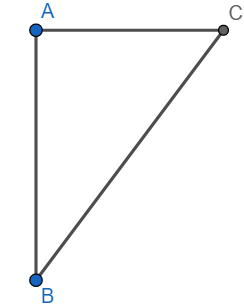Answer
414.6k+ views
Hint: Use the identity ${{\cos }^{2}}\theta +{{\sin }^{2}}\theta =1$ to find the value of $\sin \theta $. Hence find the values of $\sec \theta $ and $\csc \theta $ using the identities $\sec \theta =\dfrac{1}{\cos \theta }$ and $\csc \theta =\dfrac{1}{\sin \theta }$ respectively. Hence find the value of $\tan \theta $ and $\cot \theta $ using the identities $\tan \theta =\dfrac{\sin \theta }{\cos \theta }$ and $\cot \theta =\dfrac{1}{\tan \theta }$ respectively. Hence substitute the values of $\csc \theta ,\cot \theta ,\sec \theta $ and $\tan \theta $ to get the value of $\dfrac{\csc \theta +\cot \theta }{\sec \theta -\tan \theta }$.
Complete step-by-step answer:
We have $\cos \theta =\dfrac{-3}{5}$
We know that ${{\sin }^{2}}\theta +{{\cos }^{2}}\theta =1$
Substituting the value of $\cos \theta ,$ we get
\[{{\sin }^{2}}\theta +{{\left( \dfrac{-3}{5} \right)}^{2}}=1\Rightarrow {{\sin }^{2}}\theta +\dfrac{9}{25}=1\]
Subtracting $\dfrac{9}{25}$ from both sides, we get
${{\sin }^{2}}\theta =1-\dfrac{9}{25}=\dfrac{16}{25}$
Hence, we have $\sin \theta =\pm \dfrac{4}{5}$
Since $\pi <\theta <\dfrac{3\pi }{2}$, we have $\theta $ lies in the third quadrant.
Since sine of an angle in third quadrant is negative, we have
$\sin \theta =\dfrac{-4}{5}$.
Now, we know that $\csc \theta =\dfrac{1}{\sin \theta }$
Hence, we have $\csc \theta =\dfrac{1}{\dfrac{-4}{5}}=\dfrac{-5}{4}$
Also, $\sec \theta =\dfrac{1}{\cos \theta }$
Hence, we have $\sec \theta =\dfrac{1}{\dfrac{-3}{5}}=\dfrac{-5}{3}$.
We know that $\tan \theta =\dfrac{\sin \theta }{\cos \theta }$
Hence, we have $\tan \theta =\dfrac{\dfrac{-4}{5}}{\dfrac{-3}{5}}=\dfrac{4}{3}$.
Using $\cot \theta =\dfrac{1}{\tan \theta }$, we get
$\cot \theta =\dfrac{1}{\dfrac{4}{3}}=\dfrac{3}{4}$
Hence, we have $\dfrac{\csc \theta +\cot \theta }{\sec \theta -\tan \theta }=\dfrac{\dfrac{-5}{4}+\dfrac{3}{4}}{\dfrac{-5}{3}-\dfrac{4}{3}}=\dfrac{\dfrac{-5+3}{4}}{\dfrac{-5-4}{3}}=\dfrac{-2}{4}\times \dfrac{3}{-9}=\dfrac{1}{6}$
Hence, $\dfrac{\csc \theta +\cot \theta }{\sec \theta -\tan \theta }=\dfrac{1}{6}$
Note: Alternative solution:
Let ABC be a right-angled triangle right-angled at A. Let AC = -3 units(negative sign only describes the quadrant in which the angle lies) and BC = 5 units. Let $\angle C=\theta $.

Now, we have
$A{{B}^{2}}+A{{C}^{2}}=B{{C}^{2}}\Rightarrow A{{B}^{2}}=25-9=16\Rightarrow AB=\pm 4$
Since $\theta $ lies in the third quadrant, we have $AB<0$
Hence, AB = -4 units.
Now, we have $\sin \theta =\dfrac{AB}{BC}=\dfrac{-4}{5}$
Hence, we have $\sin \theta =\dfrac{-4}{5}$
Similarly, we have $\tan \theta =\dfrac{AB}{AC}=\dfrac{-4}{-3}=\dfrac{4}{3},\cot \theta =\dfrac{AC}{AB}=\dfrac{3}{4},\sec \theta =\dfrac{BC}{AC}=\dfrac{-5}{3},\csc \theta =\dfrac{BC}{AB}=\dfrac{-5}{4}$, which is the same as obtained above.
Proceeding similarly, we can find the value of $\dfrac{\csc \theta +\cot \theta }{\sec \theta -\tan \theta }$.
Complete step-by-step answer:
We have $\cos \theta =\dfrac{-3}{5}$
We know that ${{\sin }^{2}}\theta +{{\cos }^{2}}\theta =1$
Substituting the value of $\cos \theta ,$ we get
\[{{\sin }^{2}}\theta +{{\left( \dfrac{-3}{5} \right)}^{2}}=1\Rightarrow {{\sin }^{2}}\theta +\dfrac{9}{25}=1\]
Subtracting $\dfrac{9}{25}$ from both sides, we get
${{\sin }^{2}}\theta =1-\dfrac{9}{25}=\dfrac{16}{25}$
Hence, we have $\sin \theta =\pm \dfrac{4}{5}$
Since $\pi <\theta <\dfrac{3\pi }{2}$, we have $\theta $ lies in the third quadrant.
Since sine of an angle in third quadrant is negative, we have
$\sin \theta =\dfrac{-4}{5}$.
Now, we know that $\csc \theta =\dfrac{1}{\sin \theta }$
Hence, we have $\csc \theta =\dfrac{1}{\dfrac{-4}{5}}=\dfrac{-5}{4}$
Also, $\sec \theta =\dfrac{1}{\cos \theta }$
Hence, we have $\sec \theta =\dfrac{1}{\dfrac{-3}{5}}=\dfrac{-5}{3}$.
We know that $\tan \theta =\dfrac{\sin \theta }{\cos \theta }$
Hence, we have $\tan \theta =\dfrac{\dfrac{-4}{5}}{\dfrac{-3}{5}}=\dfrac{4}{3}$.
Using $\cot \theta =\dfrac{1}{\tan \theta }$, we get
$\cot \theta =\dfrac{1}{\dfrac{4}{3}}=\dfrac{3}{4}$
Hence, we have $\dfrac{\csc \theta +\cot \theta }{\sec \theta -\tan \theta }=\dfrac{\dfrac{-5}{4}+\dfrac{3}{4}}{\dfrac{-5}{3}-\dfrac{4}{3}}=\dfrac{\dfrac{-5+3}{4}}{\dfrac{-5-4}{3}}=\dfrac{-2}{4}\times \dfrac{3}{-9}=\dfrac{1}{6}$
Hence, $\dfrac{\csc \theta +\cot \theta }{\sec \theta -\tan \theta }=\dfrac{1}{6}$
Note: Alternative solution:
Let ABC be a right-angled triangle right-angled at A. Let AC = -3 units(negative sign only describes the quadrant in which the angle lies) and BC = 5 units. Let $\angle C=\theta $.

Now, we have
$A{{B}^{2}}+A{{C}^{2}}=B{{C}^{2}}\Rightarrow A{{B}^{2}}=25-9=16\Rightarrow AB=\pm 4$
Since $\theta $ lies in the third quadrant, we have $AB<0$
Hence, AB = -4 units.
Now, we have $\sin \theta =\dfrac{AB}{BC}=\dfrac{-4}{5}$
Hence, we have $\sin \theta =\dfrac{-4}{5}$
Similarly, we have $\tan \theta =\dfrac{AB}{AC}=\dfrac{-4}{-3}=\dfrac{4}{3},\cot \theta =\dfrac{AC}{AB}=\dfrac{3}{4},\sec \theta =\dfrac{BC}{AC}=\dfrac{-5}{3},\csc \theta =\dfrac{BC}{AB}=\dfrac{-5}{4}$, which is the same as obtained above.
Proceeding similarly, we can find the value of $\dfrac{\csc \theta +\cot \theta }{\sec \theta -\tan \theta }$.
Recently Updated Pages
Assertion The resistivity of a semiconductor increases class 13 physics CBSE

The Equation xxx + 2 is Satisfied when x is Equal to Class 10 Maths

How do you arrange NH4 + BF3 H2O C2H2 in increasing class 11 chemistry CBSE

Is H mCT and q mCT the same thing If so which is more class 11 chemistry CBSE

What are the possible quantum number for the last outermost class 11 chemistry CBSE

Is C2 paramagnetic or diamagnetic class 11 chemistry CBSE

Trending doubts
Difference Between Plant Cell and Animal Cell

Difference between Prokaryotic cell and Eukaryotic class 11 biology CBSE

Fill the blanks with the suitable prepositions 1 The class 9 english CBSE

Change the following sentences into negative and interrogative class 10 english CBSE

Summary of the poem Where the Mind is Without Fear class 8 english CBSE

Give 10 examples for herbs , shrubs , climbers , creepers

Write an application to the principal requesting five class 10 english CBSE

What organs are located on the left side of your body class 11 biology CBSE

What is the z value for a 90 95 and 99 percent confidence class 11 maths CBSE



